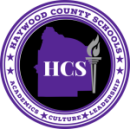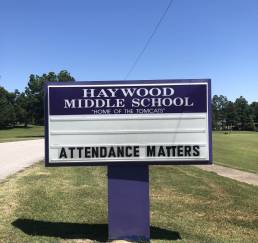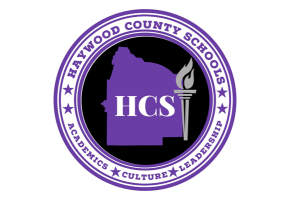Academic Focus – HMS
Teaching middle school students can be one of the most challenging jobs in education, but it can also be one of the most rewarding.
Most middle school students are at an age where general decision making is quite impaired, but the desire to learn and buy into what a teacher is teaching is still strong. It’s an age where students are beginning to question authority and discover their own ideas about what they think about certain topics. For a teacher, having students who want to form their ideas about subject matter can be extremely rewarding.
Chissolssi Jones is the Instructional Facilitator at Haywood Middle School. Before taking this position, she was an English/Language Arts teacher at HMS. She definitely understands the world of middle school students.
“My role as IF is different compared to being a classroom teacher. I have to orchestrate intervention and make sure students are grouped the way they need to be in order to learn their best,” she said. “My role now is to support teachers and students by assessing data, coordinating intervention, and helping with curriculum. I miss teaching, but I was ready to take on a new challenge.”
As part of this new challenge, Chissolssi still impacts student learning, but in a different way than she did as a classroom teacher. Chissolssi helps guide teachers through the benchmark data and also center instruction around that data. The benchmark tests used at HMS are the same tests used across the district to measure student learning – IReady and AimsWeb.
“IReady is based on state standards and those are the standards we focus on everyday in our curriculum,” Chissolssi explained. “AimsWeb is a skills based test that measures the baseline skills students need to have to be on grade level.”
Like everything, public education is constantly evolving; the way one generation experiences school isn’t necessarily the same as the way the previous generation experienced it.
For decades, success in school was measured by letter grades ranging from an A to an F. Those grades were given by teachers who possibly interpreted mastery in different ways. One teacher may think a paper is an “A” while another teacher may give that same paper a “B”. Letter grades had a tendency to be subjective, so there’s been a push to look at mastery of content rather than a letter grade, and that mastery (or lack thereof) can be found in the data.
“This year, we’re really focusing on doing a deep dive into the data. We realized that a lot of grades are subjective, but we’re going to start having conversations with students based on their benchmark test results and how well they’re mastering those state standards,” Chissolssi explained.
Like any other field or profession, there are different levels of ability within the student population; not every single student will master every educational standard in every subject. In fact, the vast majority of students are always on a path of learning more and trying to continually increase their academic trajectories. Because students find themselves at different points along their educational journey, an equitable curriculum and education are necessary for growth.
“Equity in education means that every student gets what they need to be successful. Students are different, so what they need to achieve success may also look different. Not everyone is the same and not everyone will receive the same type of instruction,” Chissolssi explained. “That’s where the data comes in because that data is individualized and so the instruction will be different, too.”
In order to ensure educational equity, HMS uses high-quality instructional material and teachers also collaborate weekly as a department to make sure students are receiving the best education possible.
“We have PLC’s that meet every week as subject levels on Tuesdays. We’re diving into the curriculum and breaking those lessons down,” Chissolssi said.
Even with all the systems and structures in place to make learning possible at HMS, Chissolssi knows that reaching middle school students can be a challenge.
“I think the biggest challenge teaching middle school kids is finding ways to reach them. There’s so much pulling at kids this age – technology, phones, texting,” she said.
Helping HMS fight against those distractions, however, is a 45 minute intervention block for all students that helps reinforce what’s being taught in classrooms.
“Every student has an intervention time at HMS. That time is valuable and uninterrupted and focuses on where each student finds themselves,” Chissolssi said.
Every grade is important in its own way when it comes to educating students, but the middle school years are often the last chance to grab the attention of students and get them engaged in their learning process. Middle school is a time of discovery and ownership for most students, and HMS is doing a wonderful job preparing those students for success in high school.


